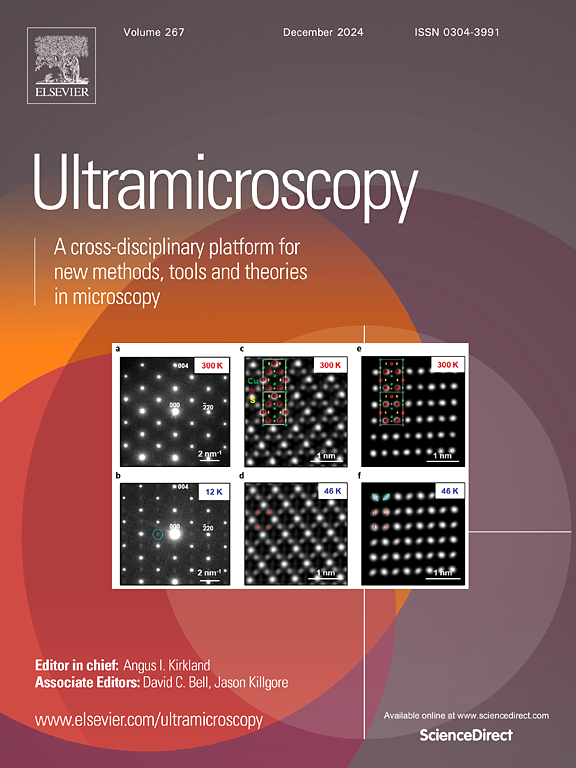STEM-EELS图反卷积的无偏ADMM-TGV算法
IF 2
3区 工程技术
Q2 MICROSCOPY
引用次数: 0
摘要
扫描透射电子显微镜(STEM)中的电子能量损失光谱(EELS)受到各种类型噪声的影响。此外,它们与探测器点扩展函数和电子源的能量分布进行了卷积。通常,迭代反卷积被用来锐化峰值和改进数据。然而,由于Richardson-Lucy算法(RLA)已成为EELS中标准的反褶积算法,在技术上几乎没有取得进展。在本文中,作者旨在提供STEM-EELS反卷积的更新,并演示如何显着改善与RLA相比可以实现的结果。RLA的主要限制是它不能保证收敛性。此外,RLA受限于纯泊松噪声,并且由于其一般结构的限制而缺乏适应性,特别是与更现代的算法相比。一种新的通用方法是乘法器的交替方向法(ADMM),它基于拉格朗日方法,能够克服这些限制。ADMM的通用性使我们能够开发适合EELS地图的反卷积算法,并结合最新的噪声模型。我们将RLA的标准贝叶斯极大似然扩展到ADMM中的最大后验方法,这使我们能够利用总一般变分(TGV)原则来强制收敛。此外,我们定义了该算法,使其对用户的操作是无偏的。为了证明ADMM的优越性,利用仿真数据对其进行了RLA测试。最后,我们的算法也成功地应用于实验数据。本文章由计算机程序翻译,如有差异,请以英文原文为准。
An unbiased ADMM-TGV algorithm for the deconvolution of STEM-EELS maps
Electron-energy-loss-spectroscopy (EELS) spectra in the scanning transmission electron microscope (STEM) are affected by various types of noise. Additionally, they are convolved with the detector point spread function and the energy distribution of the electron source. Often, iterative deconvolution is employed to sharpen peaks and improve the data. However, since the Richardson–Lucy algorithm (RLA) has become the standard deconvolution algorithm in EELS, little progress has been made in terms of technique. In this paper, the authors aim to provide an update to STEM-EELS deconvolution and demonstrate how to significantly improve results compared to those achievable with the RLA. The major limitation of the RLA is that it does not guarantee convergence. Furthermore, the RLA is restricted to pure Poisson noise and lacks adaptability due to limitations in its general structure, particularly when compared to more modern algorithms. A new and versatile approach is the Alternating Direction Method of Multipliers (ADMM), which is based on Lagrangian methods and enables to overcome these restrictions. The generality of ADMM allows us to develop a deconvolution algorithm tailored to EELS maps and incorporate a recent noise model. We extend the standard Bayesian maximum likelihood of the RLA to a maximum a-posteriori approach in ADMM, which enables us to leverage the principles of total general variation (TGV) to enforce convergence. Furthermore, we define the algorithm such that it operates unbiased of the user. To demonstrate the superiority of the ADMM, it is tested against the RLA using simulated data. Eventually, our algorithm is successfully applied to experimental data as well.
求助全文
通过发布文献求助,成功后即可免费获取论文全文。
去求助
来源期刊

Ultramicroscopy
工程技术-显微镜技术
CiteScore
4.60
自引率
13.60%
发文量
117
审稿时长
5.3 months
期刊介绍:
Ultramicroscopy is an established journal that provides a forum for the publication of original research papers, invited reviews and rapid communications. The scope of Ultramicroscopy is to describe advances in instrumentation, methods and theory related to all modes of microscopical imaging, diffraction and spectroscopy in the life and physical sciences.
 求助内容:
求助内容: 应助结果提醒方式:
应助结果提醒方式:


